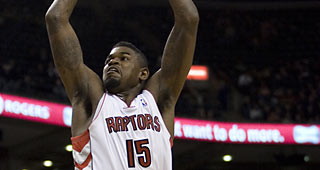There are only a few NBA players averaging at least 10 points, seven rebounds and one block per game while also shooting 55% from the field this season. LeBron James, Al Horford and Serge Ibaka.
Oh, one more. Amir Johnson.
Rudy Gay brings star power to the Raptors. DeMar DeRozan has athleticism and promise. Andrea Bargnani offers a polarizing effect on fans. Johnson? He brings his lunch pail.
Known for his grit and toughness, Johnson is enjoying a career year in Toronto. Plays aren’t run for him, but he still manages to get his points with elbow grease and hard work on the offensive glass. He grabs 12.4% of his team’s missed shots, ranking 13th in offensive rebound percentage. That helps explain his 56.5 eFG%, better than all but 10 players.
“I’m not worried about getting big numbers; I’m worried about getting wins,” Johnson said. “I really want to get one of those playoff spots.”
Unfortunately, there will no postseason for the Raptors. They stand eight games back of the Milwaukee Bucks for the eighth seed in the East with a little more than a dozen games left.
“We’ve been through a lot of ups-and-downs. At the beginning of the season we struggled and then we lost a couple of games in a row with the [Rudy Gay trade], but we’re starting to get along and improve,” Johnson reflected. “Not every team is perfect, so it’s a process.
“We just have got to keep working hard. When we get opportunities, we’ve got to take advantage and always work hard.”
Johnson, who signed a five-year, $34 million deal with the Raptors during the famed 2010 offseason, is better known as a barroom trivia answer than for his solid NBA game. He was the last high school player drafted in league history. The Detroit Pistons used the 56th overall pick on him in 2005, the last draft before the NBA age minimum was increased.
“I think it was on Jeopardy,” Johnson said with a hearty laugh. “It’s good to have kind of like a trivia question associated with your name, but that’s pretty much all it is for me.”
He may have closed the Moses Malone prep-to-pro lineage, but Johnson’s unique basketball journey doesn’t end there. He got his feet wet in the D-League long before teams and players started to embrace the minor league approach. In 40 games across two seasons (during his rookie and sophomore years) for Fayetteville and Sioux Falls, he averaged 18.1 points, 8.5 rebounds and 2.4 blocks on 64.2% shooting. More importantly than the numbers, he played more than 30 minutes a night when he would have rode the pine in Detroit.
“I actually asked to go down in the D-League. I was just working out so much and I didn’t see the floor,” he admitted. “I figured I would go down there and play a little bit. It definitely improved my game and I would say that it was basically like my college years. I developed a lot down there.”
Seven years since Johnson asked for a demotion, NBA teams have begun to regularly shuffle young players up-and-down to the 16 D-League teams. Each of the league’s 30 teams has an affiliation, often -- but not always -- based geographically. It’s not inconceivable to think that every team could have an affiliation of their own sometime in the not-so-distance future.
“It’s not a punishment,” Johnson said. “It’s not something you should put your head down about; you can use it to your advantage and get better.”
Why, then, is there still a bit of a stigma when a player doesn’t stick in the league?
“I have no idea why that is,” Johnson responded. “Any young player in the league, I’d tell them what it did for me. It’s a stepping stone; I used it to get better.”



